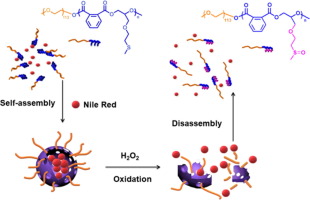当前位置:
X-MOL 学术
›
Eur. Polym. J.
›
论文详情
Our official English website, www.x-mol.net, welcomes your feedback! (Note: you will need to create a separate account there.)
Synthesis of PEGylated alternating copolymer bearing thioether pendants for oxidation responsive drug delivery
European Polymer Journal ( IF 6 ) Pub Date : 2018-10-01 , DOI: 10.1016/j.eurpolymj.2018.09.004 Yu Zhang , Pan He , Xinming Liu , Hongyu Zhang , Huailin Yang , Chunsheng Xiao , Xuesi Chen
European Polymer Journal ( IF 6 ) Pub Date : 2018-10-01 , DOI: 10.1016/j.eurpolymj.2018.09.004 Yu Zhang , Pan He , Xinming Liu , Hongyu Zhang , Huailin Yang , Chunsheng Xiao , Xuesi Chen

|
Abstract Synthetic polymers that can change their physicochemical properties in response to physiological stimuli have attracted particular interest for constructing smart drug delivery systems. In the present work, a novel oxidation-responsive block copolymer bearing thioether pendants was designed and synthesized by ring-opening alternating copolymerization (ROAP) of phthalic anhydride (PA) and 2-(methylthio)ethyl glycidyl ether (MTG) monomer using mPEG-OH as the macroinitiator and a phosphazene base, t-BuP1, as the catalyst. The obtained mPEG-b-P(PA-alt-MTG) copolymer could self-assemble into spherical micelles in water with an average size of about 30 nm and a critical micelle concentration value of 7.44 × 10−3 mg/mL. 1H NMR results indicated that the hydrophobic thioether group can be selectively oxidized to hydrophilic sulfoxide by H2O2, leading to disassociation of the micelles as illustrated by the TEM observation. Nile Red, as a model drug, was loaded into the copolymer micelles. The intensity of the fluorescence emission decreased sharply after addition of H2O2, indicating an oxidation-triggered drug release. Moreover, the drug-loaded micelles could be effectively internalized into MCF-7 cells, as indicated by the confocal laser scanning microscopy (CLSM) and flow cytometry (FCM) studies. MTT assay further demonstrated that the synthesized copolymer showed good biocompatibility towards L929 cell, even at a concentration up to 0.5 mg/mL. In sum, this kind of copolymer may have great potential applications in oxidation responsive drug delivery.
中文翻译:

用于氧化响应药物递送的带有硫醚侧链的聚乙二醇化交替共聚物的合成
摘要 可响应生理刺激而改变其理化性质的合成聚合物在构建智能药物递送系统方面引起了特别的兴趣。在目前的工作中,通过邻苯二甲酸酐(PA)和2-(甲硫基)乙基缩水甘油醚(MTG)单体的开环交替共聚(ROAP)使用mPEG- OH 作为大分子引发剂,磷腈碱 t-BuP1 作为催化剂。得到的 mPEG-bP(PA-alt-MTG) 共聚物可以在水中自组装成球形胶束,平均粒径约为 30 nm,临界胶束浓度值为 7.44 × 10−3 mg/mL。1H NMR 结果表明疏水性硫醚基团可以被 H2O2 选择性氧化为亲水性亚砜,导致胶束解离,如 TEM 观察所示。尼罗红作为模型药物被加载到共聚物胶束中。加入 H2O2 后荧光发射强度急剧下降,表明是氧化触发的药物释放。此外,如共聚焦激光扫描显微镜 (CLSM) 和流式细胞术 (FCM) 研究表明,载药胶束可以有效地内化到 MCF-7 细胞中。MTT 测定进一步证明合成的共聚物对 L929 细胞显示出良好的生物相容性,即使浓度高达 0.5 mg/mL。总之,这种共聚物在氧化响应药物递送方面可能具有巨大的潜在应用。被加载到共聚物胶束中。加入 H2O2 后荧光发射强度急剧下降,表明是氧化触发的药物释放。此外,如共聚焦激光扫描显微镜 (CLSM) 和流式细胞术 (FCM) 研究表明,载药胶束可以有效地内化到 MCF-7 细胞中。MTT 测定进一步证明合成的共聚物对 L929 细胞显示出良好的生物相容性,即使浓度高达 0.5 mg/mL。总之,这种共聚物在氧化响应药物递送方面可能具有巨大的应用潜力。被加载到共聚物胶束中。加入 H2O2 后荧光发射强度急剧下降,表明是氧化触发的药物释放。此外,如共聚焦激光扫描显微镜 (CLSM) 和流式细胞术 (FCM) 研究表明,载药胶束可以有效地内化到 MCF-7 细胞中。MTT 测定进一步证明合成的共聚物对 L929 细胞显示出良好的生物相容性,即使浓度高达 0.5 mg/mL。总之,这种共聚物在氧化响应药物递送方面可能具有巨大的应用潜力。如共聚焦激光扫描显微镜 (CLSM) 和流式细胞术 (FCM) 研究所示。MTT 测定进一步证明合成的共聚物对 L929 细胞显示出良好的生物相容性,即使浓度高达 0.5 mg/mL。总之,这种共聚物在氧化响应药物递送方面可能具有巨大的应用潜力。如共聚焦激光扫描显微镜 (CLSM) 和流式细胞术 (FCM) 研究所示。MTT 测定进一步证明合成的共聚物对 L929 细胞显示出良好的生物相容性,即使浓度高达 0.5 mg/mL。总之,这种共聚物在氧化响应药物递送方面可能具有巨大的应用潜力。
更新日期:2018-10-01
中文翻译:

用于氧化响应药物递送的带有硫醚侧链的聚乙二醇化交替共聚物的合成
摘要 可响应生理刺激而改变其理化性质的合成聚合物在构建智能药物递送系统方面引起了特别的兴趣。在目前的工作中,通过邻苯二甲酸酐(PA)和2-(甲硫基)乙基缩水甘油醚(MTG)单体的开环交替共聚(ROAP)使用mPEG- OH 作为大分子引发剂,磷腈碱 t-BuP1 作为催化剂。得到的 mPEG-bP(PA-alt-MTG) 共聚物可以在水中自组装成球形胶束,平均粒径约为 30 nm,临界胶束浓度值为 7.44 × 10−3 mg/mL。1H NMR 结果表明疏水性硫醚基团可以被 H2O2 选择性氧化为亲水性亚砜,导致胶束解离,如 TEM 观察所示。尼罗红作为模型药物被加载到共聚物胶束中。加入 H2O2 后荧光发射强度急剧下降,表明是氧化触发的药物释放。此外,如共聚焦激光扫描显微镜 (CLSM) 和流式细胞术 (FCM) 研究表明,载药胶束可以有效地内化到 MCF-7 细胞中。MTT 测定进一步证明合成的共聚物对 L929 细胞显示出良好的生物相容性,即使浓度高达 0.5 mg/mL。总之,这种共聚物在氧化响应药物递送方面可能具有巨大的潜在应用。被加载到共聚物胶束中。加入 H2O2 后荧光发射强度急剧下降,表明是氧化触发的药物释放。此外,如共聚焦激光扫描显微镜 (CLSM) 和流式细胞术 (FCM) 研究表明,载药胶束可以有效地内化到 MCF-7 细胞中。MTT 测定进一步证明合成的共聚物对 L929 细胞显示出良好的生物相容性,即使浓度高达 0.5 mg/mL。总之,这种共聚物在氧化响应药物递送方面可能具有巨大的应用潜力。被加载到共聚物胶束中。加入 H2O2 后荧光发射强度急剧下降,表明是氧化触发的药物释放。此外,如共聚焦激光扫描显微镜 (CLSM) 和流式细胞术 (FCM) 研究表明,载药胶束可以有效地内化到 MCF-7 细胞中。MTT 测定进一步证明合成的共聚物对 L929 细胞显示出良好的生物相容性,即使浓度高达 0.5 mg/mL。总之,这种共聚物在氧化响应药物递送方面可能具有巨大的应用潜力。如共聚焦激光扫描显微镜 (CLSM) 和流式细胞术 (FCM) 研究所示。MTT 测定进一步证明合成的共聚物对 L929 细胞显示出良好的生物相容性,即使浓度高达 0.5 mg/mL。总之,这种共聚物在氧化响应药物递送方面可能具有巨大的应用潜力。如共聚焦激光扫描显微镜 (CLSM) 和流式细胞术 (FCM) 研究所示。MTT 测定进一步证明合成的共聚物对 L929 细胞显示出良好的生物相容性,即使浓度高达 0.5 mg/mL。总之,这种共聚物在氧化响应药物递送方面可能具有巨大的应用潜力。



























 京公网安备 11010802027423号
京公网安备 11010802027423号